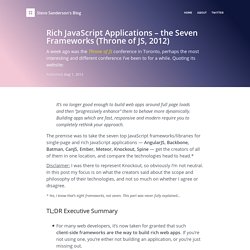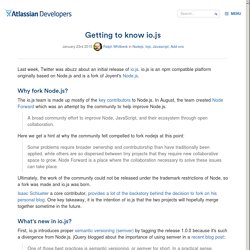

Enyo JavaScript Application Framework Test. Rich JavaScript Applications – the Seven Frameworks (Throne of JS, 2012) It’s no longer good enough to build web apps around full page loads and then “progressively enhance” them to behave more dynamically.

Building apps which are fast, responsive and modern require you to completely rethink your approach. The premise was to take the seven top JavaScript frameworks/libraries for single-page and rich JavaScript applications — AngularJS, Backbone, Batman, CanJS, Ember, Meteor, Knockout, Spine — get the creators of all of them in one location, and compare the technologies head to head.* Disclaimer: I was there to represent Knockout, so obviously I’m not neutral. . * Yes, I know that’s eight frameworks, not seven. TL;DR Executive Summary For many web developers, it’s now taken for granted that such client-side frameworks are the way to build rich web apps. Technologies: Agreement and Disagreement As each SPA technology was presented, some fairly clear patterns of similarity and difference emerged.
Agreement: Progressive enhancement isn’t for building real apps. Meteor. Introducing T3: Enabling Large Scale JavaScript Applications. When I joined Box in 2013, the web application front-end was in a typical state for a fast-growing company - what had started out as a small codebase maintained by a few engineers had grown into a massive codebase maintained by dozens of engineers.

This meant that new features were built on top of old ones and engineers feared making changes to the code because no one was sure which features the changes would affect. There were tests to help with this, but they were unreliable due to the tightly-coupled nature of the code. My team, Front-end Frameworks, was tasked with getting our JavaScript into a better state. To solve these problems, we created a new JavaScript framework called T3. T3 is short for "take 3", a nod to our two previous attempts to build a JavaScript framework for our web application.
T3 forces you to make a decision about the type of component you're building so that everything falls into one of three categories: After a few months of using T3, these were our results:
React. Aurelia. jQuery. Node.js. Angular JS. Angular 2.0. Vanilla JS. The Node.js / io.js ORM for PostgreSQL, MySQL, SQLite and MSSQL. LoopBack. Getting to know io.js - Atlassian Developers. Last week, Twitter was abuzz about an initial release of io.js. io.js is an npm compatible platform originally based on Node.js and is a fork of Joyent's Node.js.

Why fork Node.js? The io.js team is made up mostly of the key contributors to Node.js. In August, the team created Node Forward which was an attempt by the community to help improve Node.js. A broad community effort to improve Node, JavaScript, and their ecosystem through open collaboration. Here we get a hint at why the community felt compelled to fork nodejs at this point: Some problems require broader ownership and contributorship than have traditionally been applied, while others are so dispersed between tiny projects that they require new collaborative space to grow.
Ultimately, the work of the community could not be released under the trademark restrictions of Node, so a fork was made and io.js was born. Isaac Schlueter a core contributor, provides a lot of the backstory behind the decision to fork on his personal blog. Virtual Panel: Real-world JavaScript MVC Frameworks. The Web Platform has gone a long way since HTML5 was first made popular and people started looking into JavaScript as a language that could do build complex apps.

Many APIs have emerged and there is an abundance of content out there about how the browser can leverage all this. This specific article series will go a step further and focus on how these powerful technologies can be leveraged in practise, not to building cool demos and prototypes, but how real practitioners use them in the trenches. In this (post)HTML5 series, we'll go beyond buzzwords and get practical insight from experts about what has actually worked for them. We'll also talk about technologies (like AngularJS) that go a step further, and define the future of how the standards and web development will evolve.
This InfoQ article is part of the series “Next Generation HTML5 and JavaScript”. Julien Knebel: I've been developing with Ember.js for more than 2 years now on 5 production web apps. What is the best resource you know to learn Dojo. CommonJS: JavaScript Standard Library. Table of Contents - Mixu's Node book - Mixu's Node book. Enyo - HP WebOS. EraJS. Dojo Toolkit. Prototype.